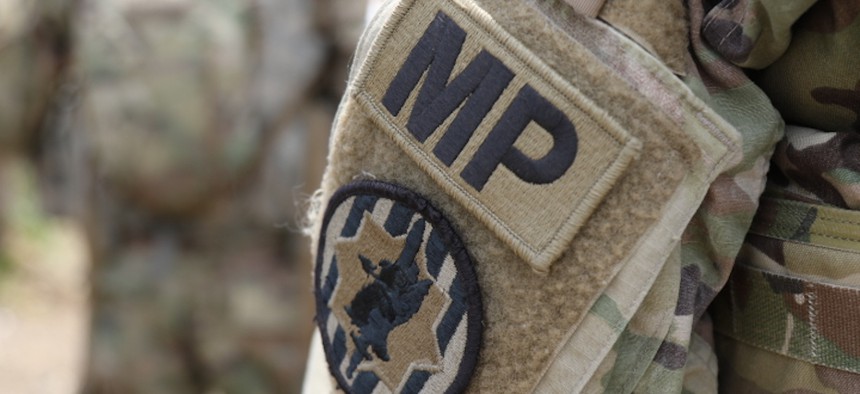
U.S. Army / Sgt. Melissa N. Lessard
Should Military Police Wear Body Cams? Congress is Asking
After BLM and Jan. 6, some say the tech is "long overdue," but others scoff that it’s "a solution in search of a problem."
After last year’s nationwide political and racial justice protests that drew National Guardsman into American streets and the Capitol Building, Congress wants to know if U.S. military police should also wear body cameras.
Following last summer’s protests against police violence targeting Black Americans, advocates such as the American Civil Liberties Union, or ACLU, called for more civilian police officers to wear body cameras, which record interactions with the public to increase transparency and accountability. Now members of Congress are considering the same for U.S. troops.
The House report on the fiscal 2022 National Defense Authorization Act, or NDAA, directs the Defense Department to study whether military police should be required to wear body cameras. Some law-enforcement-reform advocates say it’s a natural evolution for military police to catch up to their civilian counterparts. But multiple experts said putting recording devices on military police is “a solution in search of a problem,” because the military’s law enforcement community has not been accused of the same kind of brutality as community cops.
“I’ve seen most civilian police agencies adopting the use more because of transparency concerns and abuse concerns, and we just don’t have that many in the military, so I don’t know if it would be worth the cost,” said Todd Huntley, director of the National Security Law Program at Georgetown University, and a former Navy lawyer.
The House’s bipartisan study directive is an “item of special interest” in the bill’s report language. That means the Pentagon won’t have a legal requirement to follow through on the request, but agencies typically view these as demands from Congress and do respond.
House members asked the Pentagon to report to Congress by Feb. 15, 2022, on the viability and cost of military police using body cameras, and what policies the department would need about the storage and distribution of the video footage.
Some say that because military police are performing similar duties as their civilian counterparts, including traffic stops, breaking up fights, and responding to domestic violence issues on base, they should operate under the same rules. Last week, at San Diego’s Marine Corps Recruit Depot, base personnel shot and killed someone brandishing a knife at the visitor’s entrance.
“It’s long overdue for military police officers to be using the same equipment as their civilian counterparts,” said Dwight Stirling, chief executive officer of the Center for Law and Military Policy and a JAG officer in the California National Guard. “It’s simply a matter of accountability….I’m quite surprised it took until the current day to have the study performed.”
Body cameras have more benefits than just catching brutality on film, and could be useful for military law enforcement units even if police violence isn’t happening, said Charles Stephenson, a senior advisor at CNA Corporation and retired Army officer. Body cameras can help officers collect evidence or ensure written reports are accurate. They’re also a training tool, Stephenson argued, saying that training officers can review the footage with junior personnel to improve or correct policing practices.
“Most officers don’t want to go out without their body-worn camera just like any other piece of equipment that’s vital to their safety,” said Stephenson, who has been part of the Body-Worn Camera Training and Technical Assistance organization since 2015.
All four experts who spoke with Defense One agreed that studying the issue is a smart idea.
Even though military law enforcement personnel do not have the same record of brutality problems as their civilian counterparts, there are still racial disparities in the military justice system. Black service members are twice as likely to face a court martial, according to a 2020 Government Accountability Office report. In part, officials are more likely to report crimes committed by Black service members, said Rachel VanLandingham, a law professor at Southwestern Law School and retired Air Force JAG. Wearing body cameras could provide valuable data about whether police are contributing to the disparity in court martials by stopping Black troops and tracking them more closely, she said, though VanLandingham acknowledged the Defense Department also could also gather similar data by requiring police to document more details about their interactions with the public, including the race of people they stop.
“We don’t have reports of black men being shot by military police...but we don’t know the racial profiling composition of who they’re stopping on base, [or] who they’re writing a report on,” she said. “I do think there’s a lesser cause for concern for military police regarding their conduct versus civilian police.”
Other federal law enforcement officers already are required to wear body cams. The Justice Department announced in September that law enforcement officers would need to wear body cameras “during pre-planned law enforcement operations.” Agents with the Bureau of Alcohol, Tobacco, Firearms, and Explosives in Phoenix and Detroit began using them in September, while officials with the Drug Enforcement Administration, the FBI, and the U.S. Marshals Service will implement the change next.
At about one dozen Air Force installations, military police were wearing body cameras, but the service ordered them to stop in July and dispose of the equipment because there was no military-wide direction or guidance governing the use of cameras and storage of footage.
Several experts said they expect the Pentagon to push back against the idea of outfitting officers with body cams. Defense Department leaders will need to figure out how to protect the video footage database from potential cyberattacks, Huntley said, especially if it captures sensitive or classified information, such as footage of equipment or the layout of an installation.
“If I’m an adversary, and I know there’s this database of footage from inside a military installation, I don’t have to send someone to take photos, I just have to hack the database,” he said. “The cyber and data concerns on the back end of this are going to be huge.”
Others like Stirling, dismissed the concern as “totally false,” noting that military police officers are not accessing restricted areas of the base. Instead, they are protecting areas where even members of the public can walk around base with a smartphone camera.
“It will be the standard type of playbook where leadership says we can not comply with civilian standards because we are the military and stop looking at our business,” Stirling said. “That simply is an attempt to escape from accountability.”







